ESG Ratings and SFDR Regulation Compliance
Integrating ESG ratings with SFDR regulation transforms sustainable finance. Strategies for compliance, transparency's role, and future trends are discussed. The importance of reliable ESG assessments and alignment with evolving standards shapes a sustainable financial ecosystem.

Asset managers and other financial market participants are required by EU legislation known as the Sustainable Finance Disclosure Regulation (SFDR) to report Environmental, Social, and Governance (ESG) information pertaining to their investment decisions and financial products [1]. Regardless of whether the financial instruments are labeled as sustainable, these disclosures must be made [1]. The goal of SFDR is to increase understanding of sustainability risks and increase transparency so that investors may make better decisions [1]. For financial institutions operating in the EU, SFDR compliance and upholding a strong ESG rating are therefore essential since they show a dedication to sustainable practices and have the potential to sway investor decisions [1] [2].
Source
[1]

The incorporation of Environmental, Social, and Governance (ESG) standards into investment plans represents a paradigm shift in the financial sector's approach to sustainable development. On February 6, 2024, the European Parliament and the Council of the European Union attained a significant milestone with the tentative agreement.
As the cornerstone of sustainable investment, this agreement ushers in a new age focused on improving the transparency, integrity, and dependability of ESG ratings. The goal of reshaping the financial industry is to integrate sustainability and ethical governance at its core through the implementation of comprehensive regulatory frameworks, such as the Corporate Sustainability Reporting Directive (CSRD), the Sustainable Finance Disclosure Regulation (SFDR), and the regulation on ESG rating activities.
ESG Ratings and Regulatory Frameworks
Investors must evaluate the sustainability and ethical impact of their investments using ESG ratings, which offer insights into:
- Environmental Risk Management: How businesses handle environmental concerns is known as environmental risk management.
- Community Engagement: The methods via which businesses interact with local communities.
- Governance Practices: How businesses maintain the highest levels of governance.
The most current changes seek to standardize the way ESG ratings are provided by:
- ESMA Authorization and Supervision: Guaranteeing that ESG ratings are impartial, clear, and fairly represent sustainable practices.
- Reducing Conflicts of Interest: Fostering an inventive and competitive atmosphere for rating agencies.
Key Regulatory Mandates:
- Financial market participants and advisors are required under SFDR to disclose:
- How ESG risks are incorporated into financial decisions.
- The effect of their investment choices on sustainability.
- The purpose of CSRD is to enhance the caliber and extent of sustainability reporting through:
- requiring businesses to submit sustainability data in a uniform, online format.
- improving the consistency and dependability of ESG data.
Together, these projects aim to establish a standard in the industry where sustainable investment is accepted as the usual by integrating sustainability into the financial decision-making process. The investment landscape is about to change as a result of this shift toward sustainable finance, underscoring the necessity for investors, financial institutions, and businesses to adjust to these changing requirements. A shift towards a financial environment that is more ethical, transparent, and sustainable is highlighted by the emphasis on ESG standards.
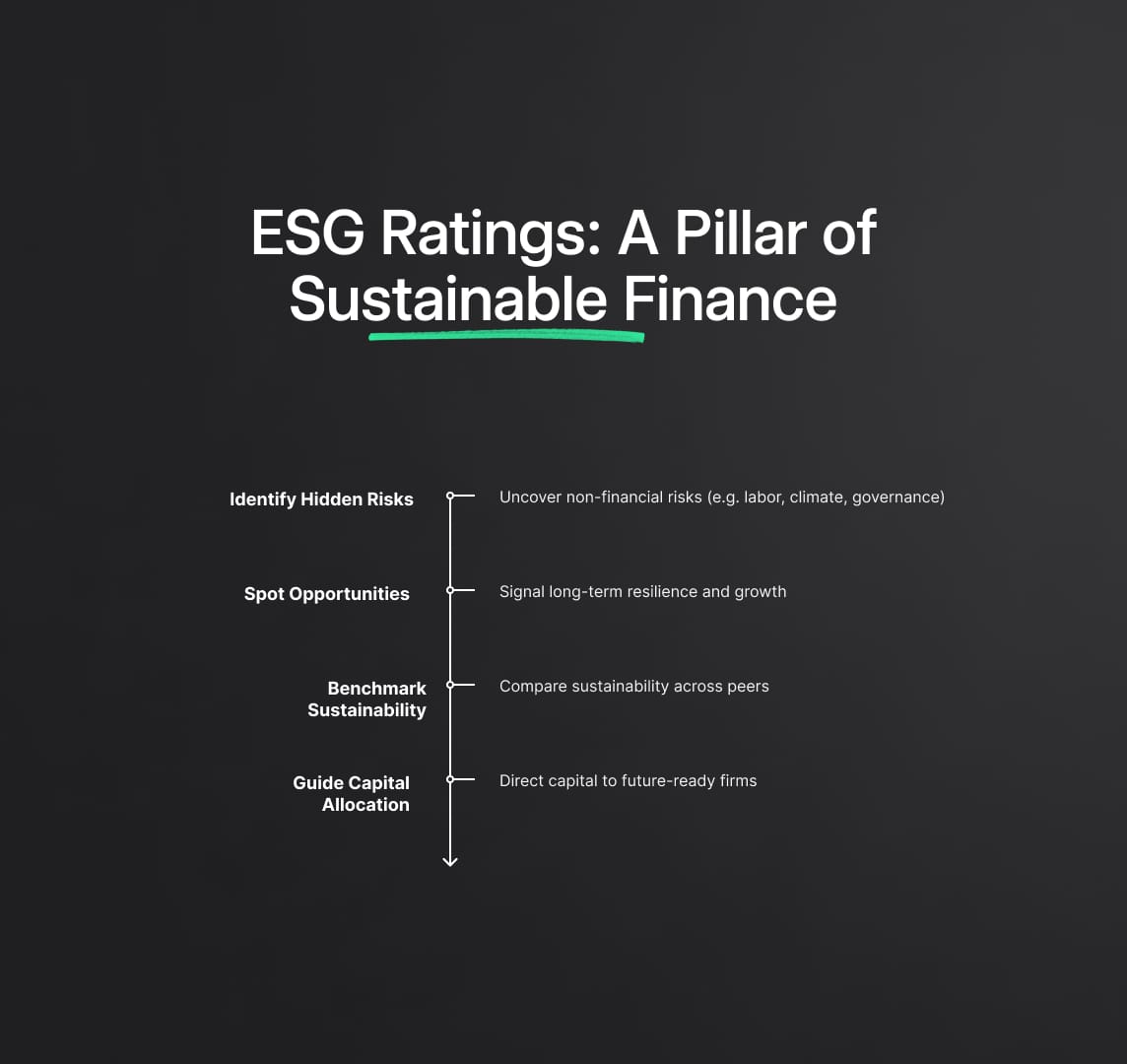
ESG Ratings: A Pillar of Sustainable Finance
With their capacity to provide a multifaceted perspective of a company's activities concerning environmental stewardship, social responsibility, and governance standards, ESG ratings have become a key component in the evaluation of corporate sustainability. For investors, these ratings are an essential instrument that allows them to:
- Determine Risks and possibilities: Investors can find possible risks and possibilities with the use of ESG ratings, which are not always visible with conventional financial research. This entails evaluating, among other things, a company's susceptibility to labor abuses, board diversity, and climate change.
- Benchmark Performance: To have a better knowledge of which companies are at the forefront of sustainability practices, investors utilize ESG ratings to compare companies within the same industry.
- Motivate Investment Decisions: Investors can direct capital toward businesses that are more likely to succeed over the long run because of their sustainable practices by incorporating ESG ratings into their analysis.
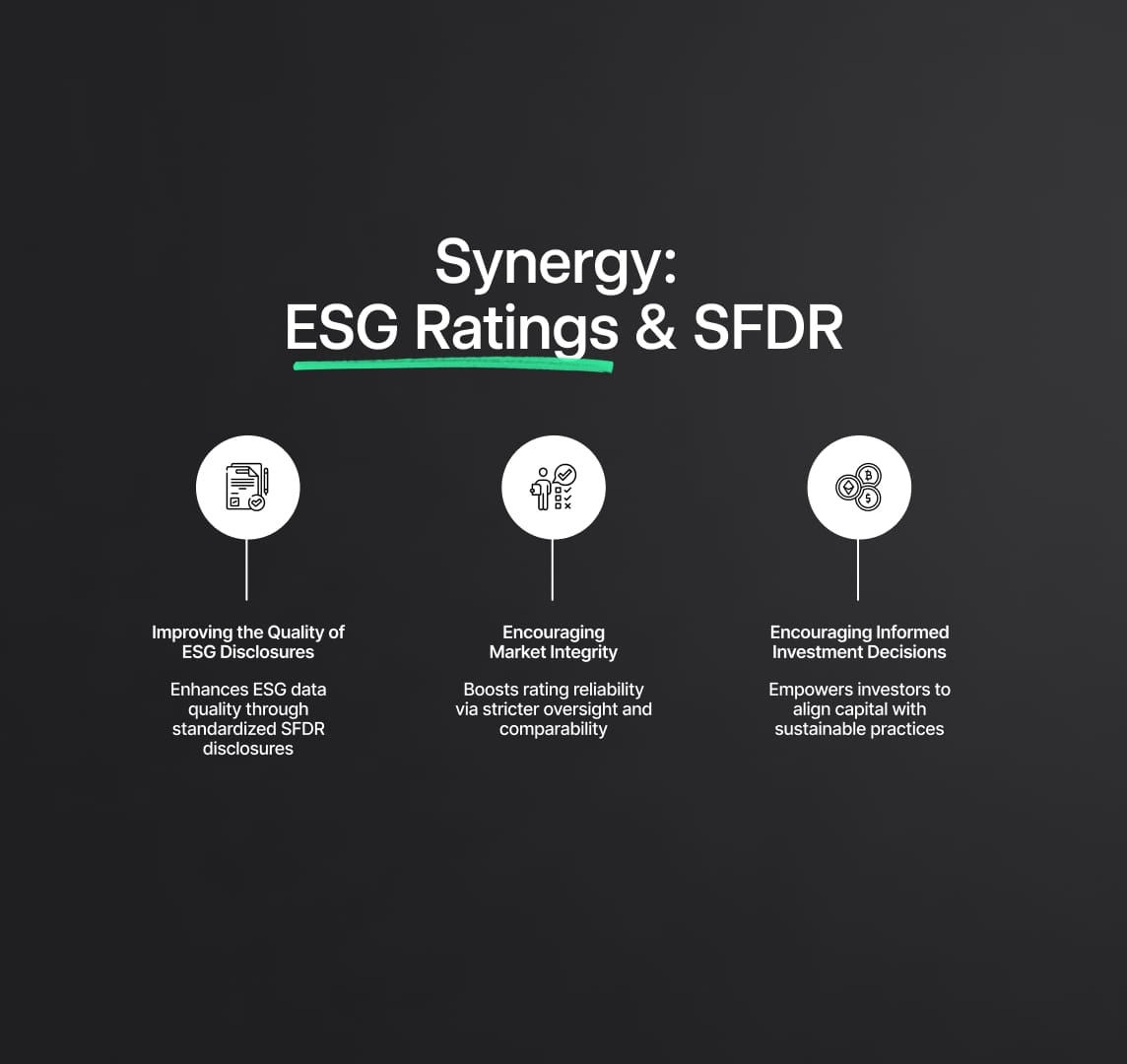
Synergistic Relationship Between ESG Ratings and SFDR
The way that SFDR regulation and ESG ratings interact is changing the sustainable finance scene in the following ways:
- Improving the Quality of ESG Disclosures: SFDR pushes businesses to give more standardized and thorough information on sustainability issues, which raises the caliber of ESG ratings and increases their accuracy.
- Encouraging Market Integrity: The SFDR regulatory framework gives the ESG rating process an extra degree of inspection and monitoring, making sure the ratings are based on reliable and comparable data.
- Encouraging Informed Investment Decisions: By providing investors with the knowledge they need to make better decisions, the combination of thorough ESG ratings and SFDR-driven disclosures aligns capital with ethical and sustainable business practices.
Implications for the Global Investment Landscape
In addition to changing investment strategies within the European Union, the merger of SFDR law and ESG ratings is also creating a precedent for international financial markets. Transparent and trustworthy ESG information is becoming more and more in demand as investors place a higher priority on sustainability. Global investment flows towards more resilient and ethical enterprises are being influenced by this trend, which is pushing businesses all over the world to embrace more sustainable practices.
In conclusion, a revolutionary change in sustainable finance is being sparked by the complementary interaction between SFDR regulation and ESG ratings. These advancements are creating a financial ecosystem that puts long-term sustainability and ethical governance first by encouraging greater openness, accountability, and integrity. This will have a significant impact on the global investment environment.
Key Components of ESG Ratings
- Environmental Stewardship: This component assesses how an organization manages waste, energy efficiency, carbon emissions, and the sustainability of its resources in relation to the environment. Evaluating a company's ability to reduce its environmental impact while supporting ecological preservation is the aim.
- Social responsibility: This facet looks at how an organization handles its interactions with customers, suppliers, workers, and the local community in which it conducts business. Labor laws, employee rights, health and safety precautions, and community involvement are important factors to take into account. The emphasis is on a business's capacity to uphold fair business practices and promote a positive social impact.
- Ethical Governance: Governance evaluates the effectiveness of a business's internal controls, leadership, executive compensation, audits, and shareholder rights. It examines how a corporation maintains ethical behavior, accountability, and openness in its operations, decision-making procedures, and stakeholder interactions.
Methodology Behind ESG Ratings
ESG ratings are determined by a thorough examination of the above described elements, which makes use of both quantitative information and qualitative evaluations. Rating agencies obtain data from publicly available disclosures, sustainability reports, and occasionally by direct communication with the companies. After each component is evaluated and given a score, a composite score representing the company's overall performance in relation to all ESG criteria is produced.
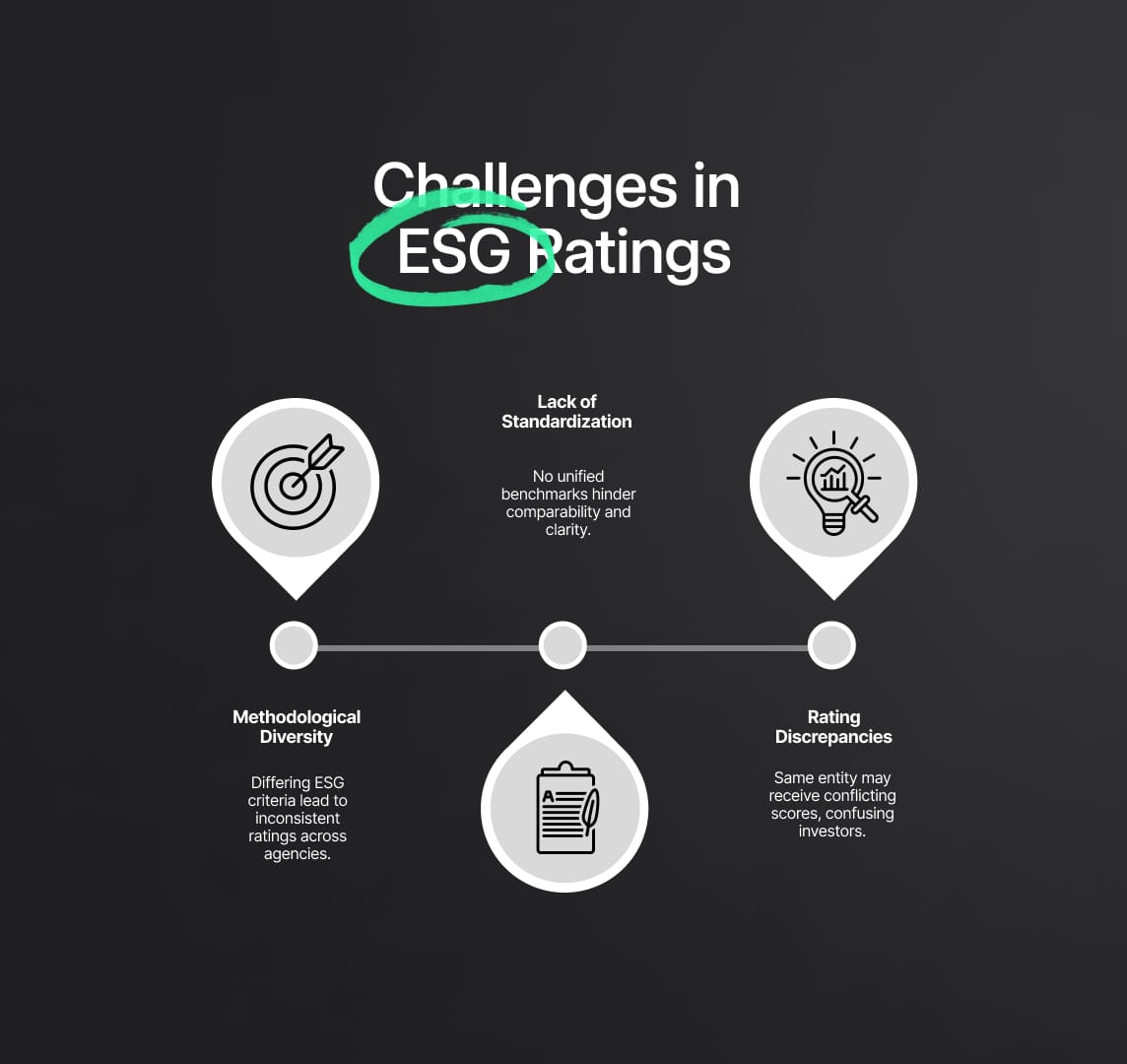
Challenges in ESG Ratings
Notwithstanding their significance, ESG evaluations encounter a number of difficulties that may compromise their efficacy and dependability:
- Methodological Diversity: The way rating agencies define, prioritize, and assess ESG criteria varies greatly. Because of this variation, ratings may become inconsistent, which makes it challenging for investors to make direct comparisons between various agencies.
- Lack of Standardization: Ratings aren't usually directly comparable because there isn't a single set of benchmarks or standards for ESG assessments. Due to this lack of standardization, investors may become confused and find it more difficult to use ESG ratings as a tool for making wise investment decisions.
- Discrepancies in Ratings: The ESG ratings given to the same entity by different agencies may differ due to methodological issues and subjective components in ESG assessments. Investors looking to compare and make decisions using ESG ratings may find this unpredictability problematic.
Enhancing the Utility and Reliability of ESG Ratings
Several tactics can be used to overcome these issues and enhance the breadth and usefulness of ESG ratings, including:
- Encouraging Transparency: Rating agencies should improve the clarity of their processes, particularly the way they consider various aspects and arrive at conclusions. This would facilitate better decision-making for investors by illuminating the methodology behind the ratings.
- Working Towards Standardization: To enable more uniform and comparable ratings amongst agencies, the sector should endeavor to reach an agreement on important ESG indicators and standards.
- Promoting Best Practices: Promoting best practices in ESG reporting among businesses can enhance the standard and accessibility of data used in ESG evaluations, resulting in ratings that are more precise and trustworthy.
ESG ratings can become more transparent and helpful for investors wishing to make ethical and sustainable investment decisions by addressing these issues and implementing these solutions. In the end, this progression will help create a more responsible and sustainable global financial ecosystem by strengthening the role that ESG ratings play in directing sustainable investment plans.
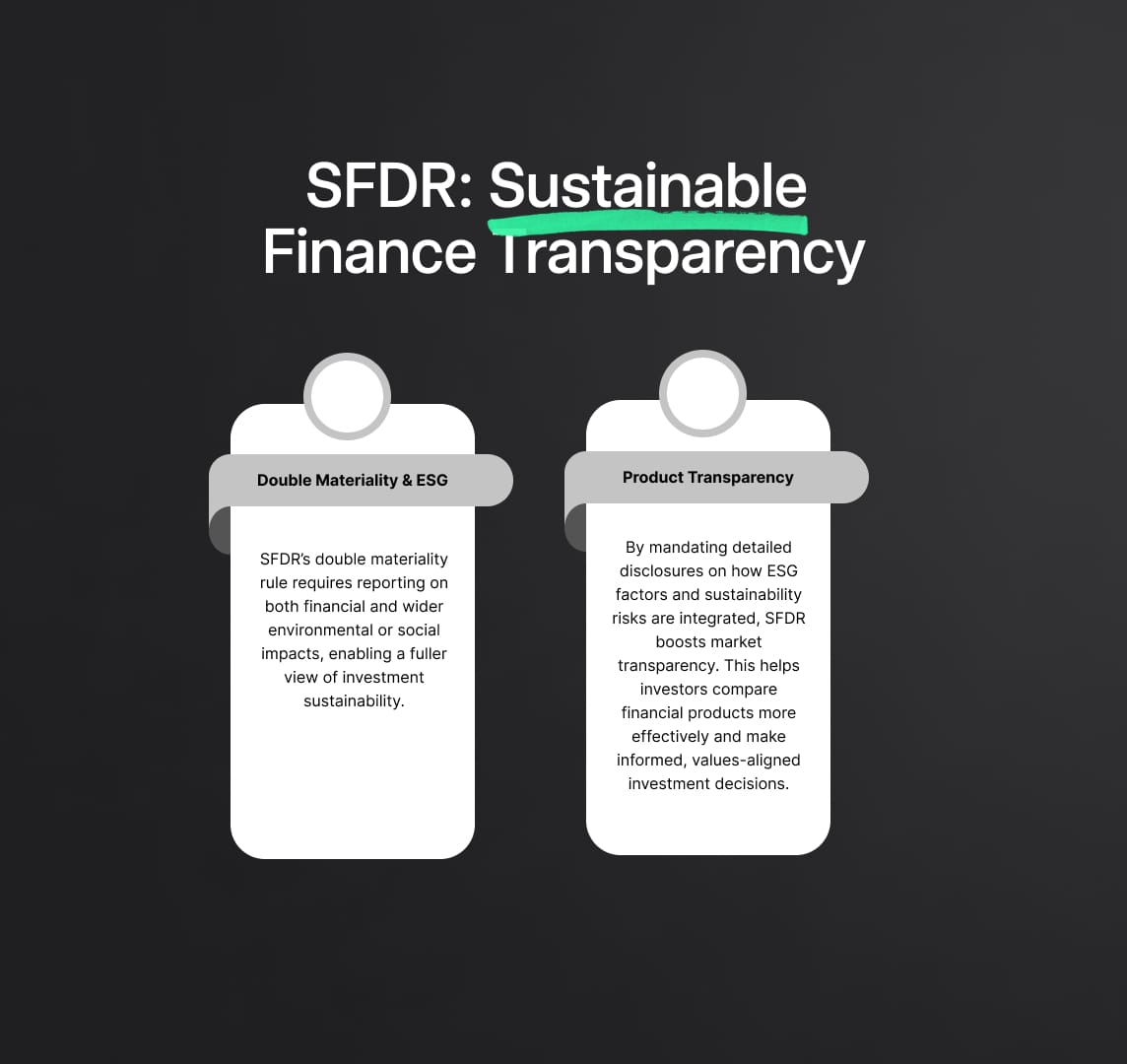
SFDR Regulation: Enhanced Transparency and in Sustainable Finance
With the primary goal of increasing openness throughout the industry, the Sustainable Finance Disclosure Regulation (SFDR) is a revolutionary change in the sustainable finance landscape. The SFDR, a key regulatory framework in the EU, imposes stringent disclosure requirements on financial market players in an effort to counteract the pervasive hazards associated with greenwashing. In order to ensure that sustainable finance is open and accountable, these disclosures concentrate on how Environmental, Social, and Governance (ESG) factors are integrated into investment decision-making and advisory processes.
Deepening the Understanding of Double Materiality
The novel idea of double materiality lies at the core of the SFDR. According to this principle, disclosures have to address investments' substantial social and environmental repercussions in addition to their financial impact. This dual viewpoint promotes a more comprehensive method of evaluating an investment's sustainability by going beyond conventional financial measurements and taking into account the more extensive and frequently intangible effects of social and environmental variables. By doing this, the SFDR promotes a better comprehension and appreciation of the risks and actual value of sustainable investments.
Elevating Market Transparency Through Detailed Disclosures
By mandating comprehensive disclosures, the SFDR raises the bar for market openness. Financial companies are required to disclose how they integrate ESG criteria into their investment procedures, including the details of their risk assessments for sustainability and how they account for unfavorable sustainability implications. By giving investors a clear, thorough understanding of how sustainability considerations are incorporated into investment products and strategies, these disclosures hope to facilitate the comparison and assessment of financial products based on their sustainability performance.
SFDR as a Tool for Combatting Greenwashing
Standardizing the reporting and disclosure of sustainability information throughout the EU financial market is one of the main objectives of the SFDR. In order to stop companies from making false or deceptive claims about the sustainability of their investment products, this is essential in the battle against greenwashing. The SFDR guarantees that all market players are held to the same high standards of transparency and integrity by creating a uniform framework for sustainability disclosures, empowering investors to make well-informed decisions based on dependable and comparable data.
Setting Precedents for the Integration of Sustainability Considerations
In addition to offering investors a more comprehensible and comparable set of data, the SFDR establishes a new benchmark for incorporating sustainability concerns into financial products and investment strategies. By placing sustainability at the center of financial decision-making processes, it forces financial firms to reconsider and reorganize their investment strategies. This regulatory framework sets precedents that will probably impact international norms and practices in sustainable finance by serving as a model for how sustainability might be integrated into financial services.
Synergy between ESG Ratings and SFDR Regulation for Sustainable Finance
A significant development in the sustainable finance industry is the thoughtful incorporation of Environmental, Social, and Governance (ESG) ratings with the Sustainable Finance Disclosure Regulation (SFDR). In order to create a strong market for sustainable investments, it is imperative that clear, accurate, and comprehensive information on sustainability practices be provided. This cooperative method guarantees just that. We go into depth about the advantages of this integration for the financial ecosystem below, along with the next measures to resolve current issues.
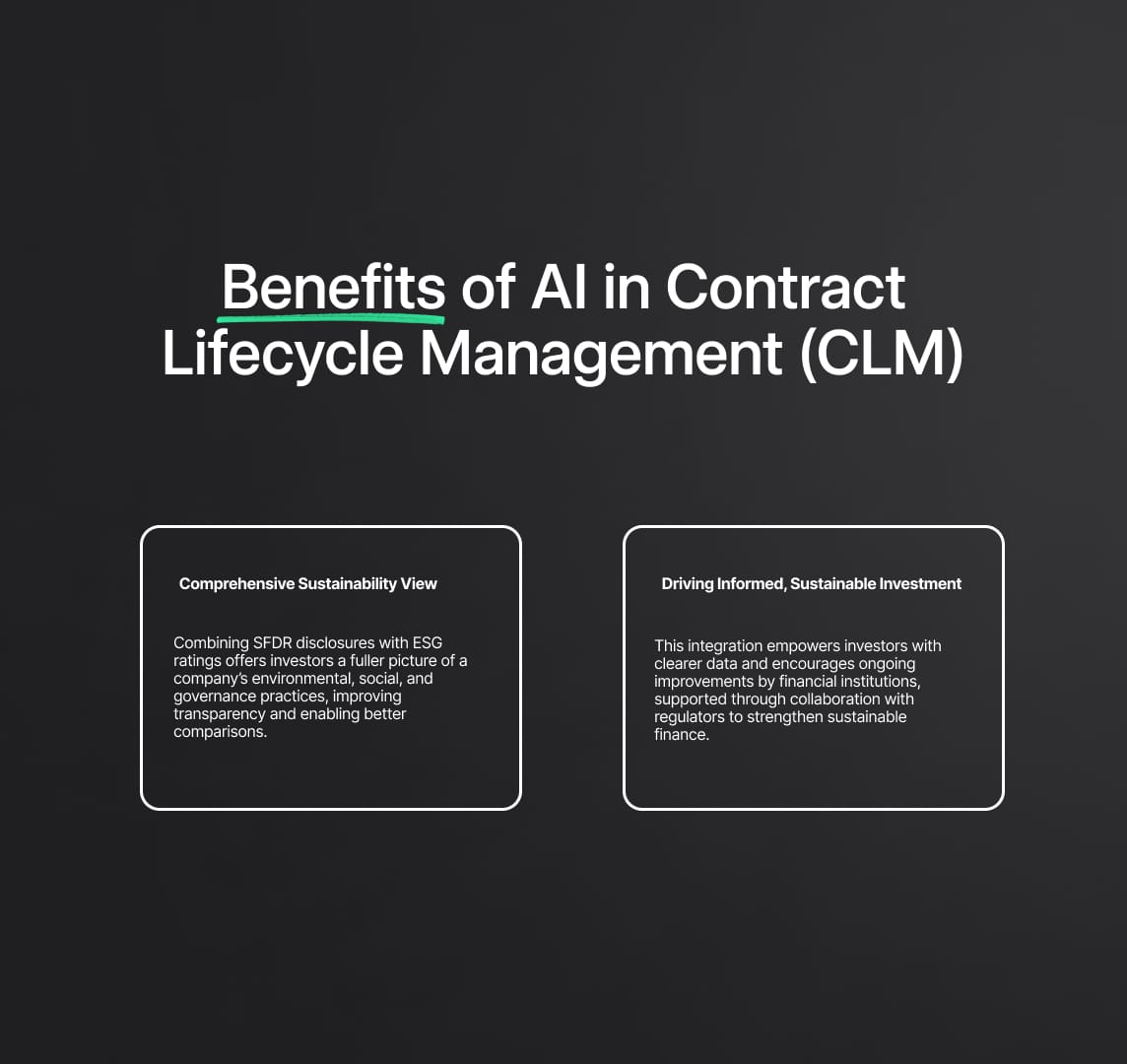
Benefits of Integrating ESG Ratings with SFDR Regulation
- All-encompassing Sustainability insights: By fusing SFDR disclosures with ESG ratings, investors may get a comprehensive understanding of a company's sustainability policies, including social responsibility, environmental stewardship, and ethical governance.
- Enhanced Market Transparency: Investors can compare and make more informed decisions with ease thanks to this synergy, which guarantees transparent and trustworthy sustainability assessments.
- Empowered Investor Decisions: By providing investors with comprehensive qualitative and quantitative data, investors may better assess the ethical and sustainable implications of their investment decisions, promoting an environment where informed decision-making is valued.
Enhancing the Investment Landscape
- Continuous Improvement: To completely adopt the integrated framework of SFDR legislation and ESG ratings, investors and financial institutions should concentrate on modifying and enhancing their procedures.
- Cooperation: To improve and put these frameworks into practice, investors, financial institutions, and regulatory bodies must work together to strengthen the sustainable financing market.
Effective Compliance Strategies and Future Outlook in Sustainable Finance
Financial institutions and ESG rating agencies must take calculated steps to navigate the regulatory environment of sustainable finance. Sustainable investment practices will be crucial in the future because to the developing frameworks like the Corporate Sustainability Reporting Directive (CSRD) and the Sustainable Finance Disclosure Regulation (SFDR). Here, we highlight the importance that these initiatives play in fostering a sustainable financial environment by dissecting the essential tactics for attaining compliance and providing insights into the changes that the investment sector is likely to undergo.
Key Strategies for Compliance
- Securing ESMA Authorization:
- To ensure credibility, obtain license from the European Securities and Markets Authority (ESMA).
- Show that you follow the principles of impartiality, accuracy, and transparency while using ESG grading systems.
- Transparent Disclosure:
- Transparently disclose evaluation criteria, data sources, and rating systems.
- Facilitate well-informed decision-making grounded in transparent ESG evaluations to bolster investor confidence.
- Continuous Monitoring and Adaptation:
- Keep abreast of changing sustainability standards and regulations.
- To be compliant, make regular improvements to your disclosure procedures and ESG evaluation procedures.
Future Outlook: Sustainable Investment Practices
The SFDR and CSRD are leading the regulatory changes that are intended to significantly accelerate the transition to ethical and sustainable investment practices. These frameworks improve the consistency and dependability of ESG ratings, which impacts capital market dynamics and investment choices. This is what to anticipate:
- Increased Demand for Transparency and Accountability:
- A rising focus on investment strategies and transparent, accountable ESG reporting.
- Stakeholders and investors will demand more thorough ESG analyses and open disclosures.
- A Paradigm Shift in Investment Strategies:
- Ethical and sustainable factors will be taken into account while making investing decisions.
- The financial markets will establish new standards for investments by giving social responsibility and long-term sustainability priority.
- Leading the Sustainable Finance Transformation:
- The shift to sustainable finance will be spearheaded by financial institutions and ESG rating agencies that value openness and adjust to regulatory changes.
- A sustainable financial environment will be developed with the help of strategic compliance initiatives.
Financial institutions and ESG rating providers can effectively traverse the intricacies of sustainable finance by adopting these techniques and staying aligned with the constantly developing regulatory requirements. The prediction for the future emphasizes how crucial it is to include sustainability into the foundation of financial operations, bringing in a new era of investing that places a premium on long-term resilience and ethical governance.
Reduce your
compliance risks


